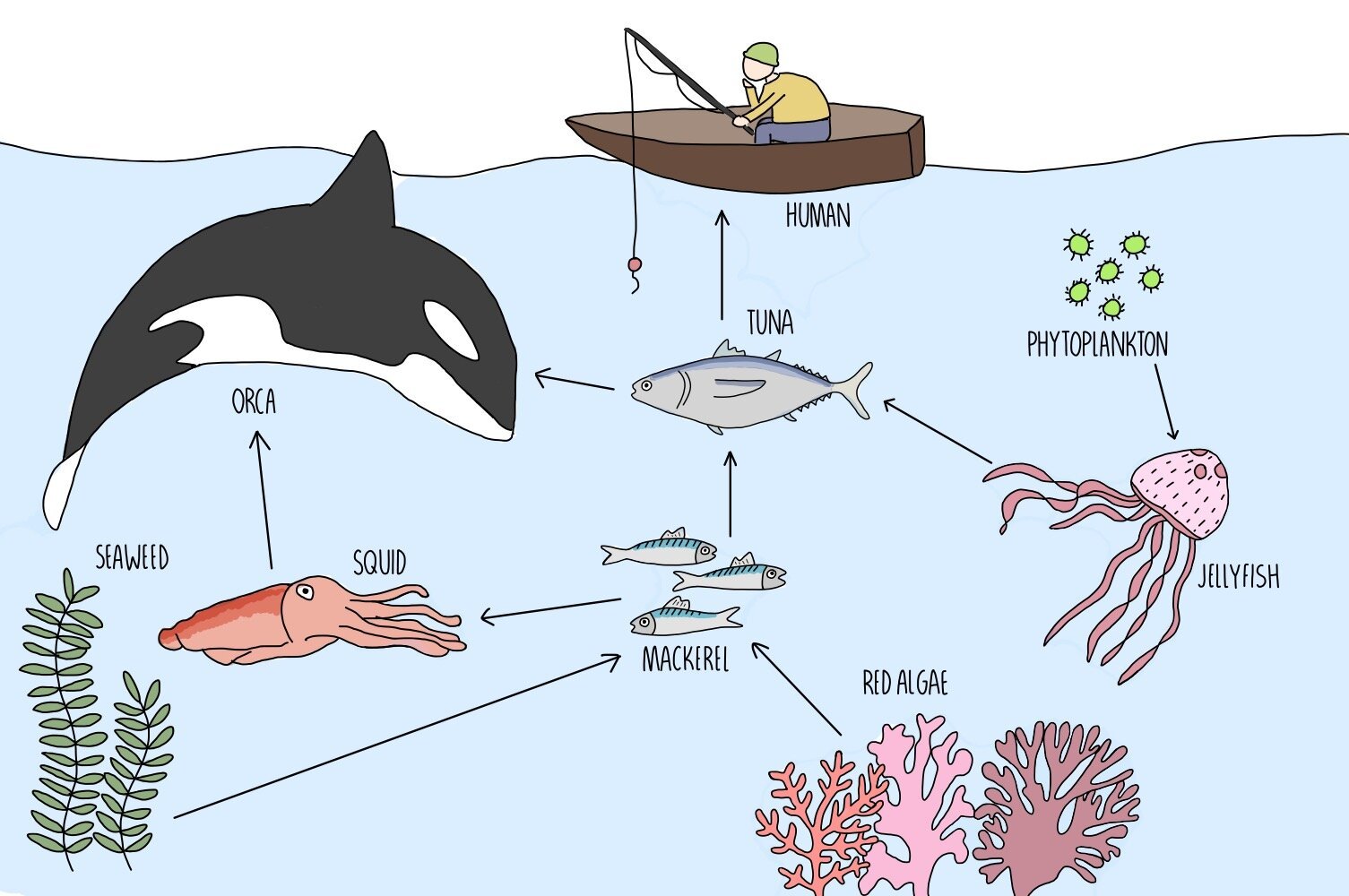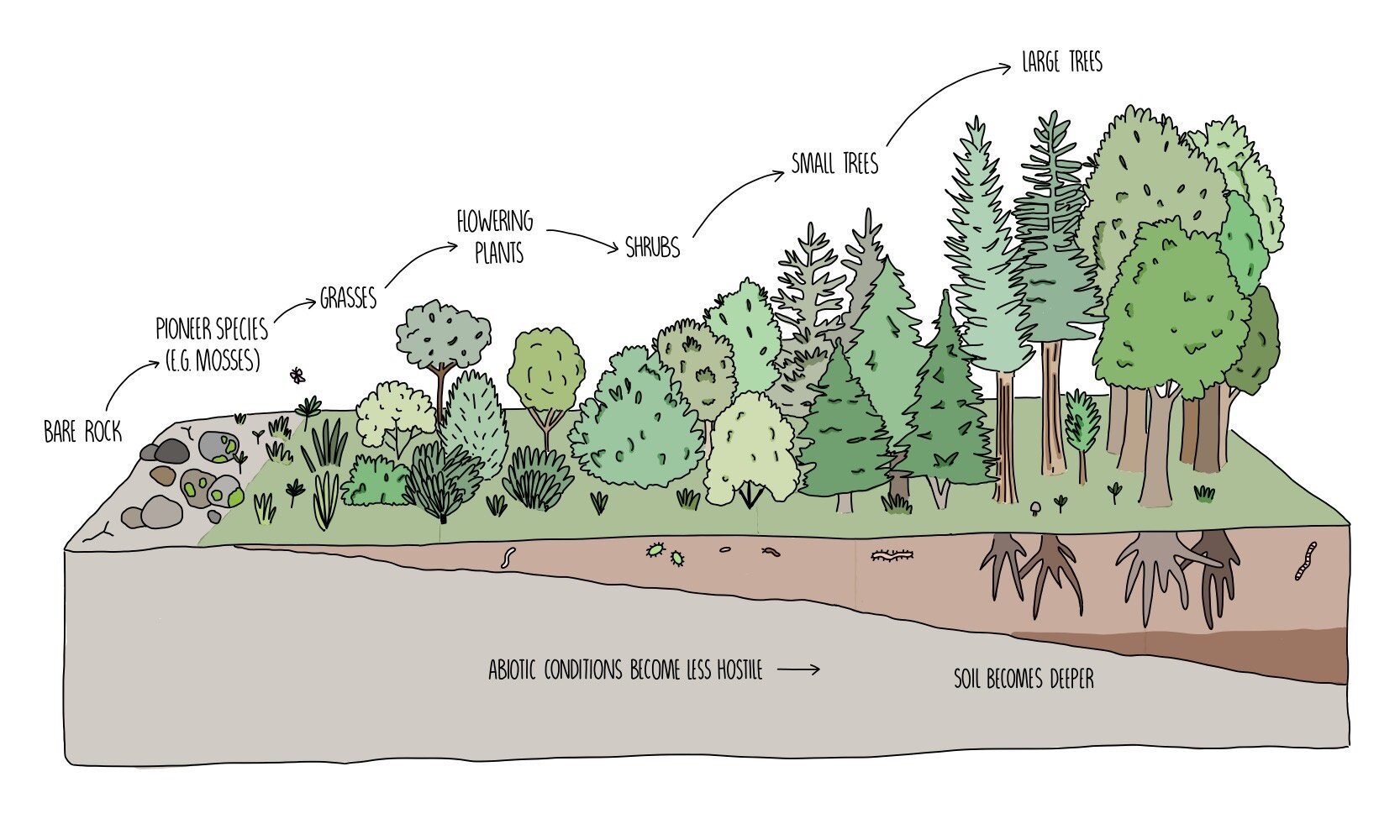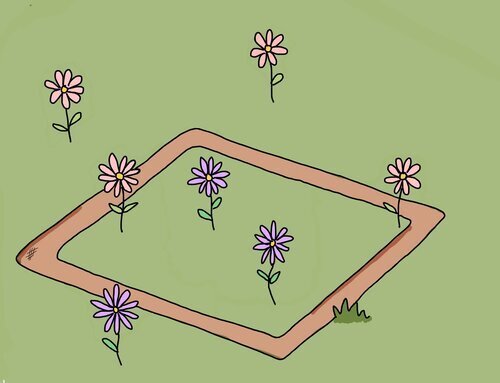Ecosystems
Ecology definitions
You need to be able to understand and define the following keywords which can be used to describe different groups within the environment:
Population: all the members of a single species which live in the same area
Habitat: the area in which an organism lives
Community: all the populations of different species which interact together in the same habitat
Ecosystem: a community of organisms and the habitat in which it lives (i.e. both the biotic and abiotic factors)
Producer: an organism which converts light energy into organic molecules. It is the first organism in a food chain.
Consumer: an organism which eats other organisms to gain energy.
Trophic level: the stage in a food chain made up of a particular group of organisms. Producers, primary consumers, and secondary consumers are examples of different trophic levels.
Decomposers: organisms which feed on, and break down, dead organisms and waste materials. They play an important role in nutrient recycling.
Biotic factors: the living features of an ecosystem. The number of predators, food availability and infectious disease are examples of biotic factors.
Abiotic factors: the non-living features of an ecosystem. Light availability, rainfall and soil pH are examples of abiotic factors.
Food chains
We can use food chains to show which organisms feed on other organisms within an ecosystem and therefore the flow of energy from one organism to another. Energy always starts from the Sun and is converted into glucose by photosynthesis in green plants. Glucose is used in respiration to generate energy which is used to help the organism to grow (increase in biomass). Organisms which produce biomass by capturing the energy from sunlight are called producers and are at the beginning of every food chain. An organism which feeds on a producer are called primary consumers and will also be herbivores, since producers tend to be mostly green plants. The next organism in the food chain is the secondary consumer which will be eaten by the tertiary consumer.
Food webs
Food webs show the interaction of multiple interconnected food chains within an ecosystem. For example, in the marine ecosystem pictured below there are a number of food chains which are all connected together. You can see that if the population size of any of these organisms changes, it will affect all the other organisms in the food web. This is known as interdependence. For instance, if the number of squid in the ocean decreased, this would boost mackerel populations (as there are fewer squid to eat them) and reduce the amount of seaweed and red algae, since there are more mackerel consuming these plants.
Decomposers are also part of food webs. They break down dead material and allow nutrients to be recycled.
Energy transfer through ecosystems
Energy enters the food chain when producers absorb light energy and convert it into chemical energy during photosynthesis. The energy is used for the plant for growth and becomes biomass (biomass describes any living matter). When primary consumers eat the plants, the energy (and biomass) is transferred to the next trophic level. The energy is eventually passed onto secondary and then tertiary consumers.
Only a small proportion (around 40%) of the energy at one trophic level is passed on to the next. The rest is lost in the following ways:
Not all the light energy that hits the plant will be absorbed - some will hit non-photosynthetic parts of the plant (e.g. the tree trunk). Of the light energy that does hit a photosynthetic pigment, not all of it can be absorbed because it is the wrong wavelength (e.g. chlorophyll pigments are unable to absorb green parts of the visible spectrum, which is why they appear green to us).
Not all parts of an organism are eaten e.g. bones, beaks and roots. The energy is transferred to decomposers.
Consumers may not be able to completely digest the organism - e.g. humans are unable to completely break down plant cell walls and is converted into faeces. The energy is passed onto decomposers.
Of the 40% of total energy that is passed onto the next trophic level, only a quarter (10%) is converted into biomass and will be available to the next trophic level. The remaining 30% is used in respiration, movement and maintaining body temperature. This explains why food chains rarely exceed four or five trophic levels - there isn’t enough energy remaining by the time it is transferred to the tertiary consumer.
Measuring energy transfers between trophic levels
The official method of measuring energy transfers between trophic levels is to essentially roast the organisms in the oven to dehydrate them, weigh them and calculate the difference in mass between organisms at different trophic levels. That’s all fine for plants but not such a nice experiment where animals are involved. For this reason, scientists would usually estimate the dry mass of animals instead. Here’s the method anyway:
- Choose the area that you want to sample - e.g. a m2 area of woodland.
- Dry the different organisms in the food chain in an oven until their mass becomes constant - at this point you can be sure that all the water has been removed and you're left with only the dry mass (biomass).
- Multiply the results of the sample by the size of the total area (e.g. to work out the biomass of that organism in 1500 m2 of woodland.
- The difference in biomass between the trophic levels is the same as the amount of biomass transfer (or energy transfer) between the organisms.
The limitations with this approach are that it assumes that each consumer only consumes one type of organism - it wouldn’t work for consumers which feed on multiple food sources.
Net Productivity
Biomass is the amount of energy that is available to the next trophic level - it can also be referred to as net productivity. You can think of this as the amount of weight an organism has been able to pack on - the fatter the organism, the more food (and energy) will be available for the organism that is going to eat it. Net productivity is calculated by taking the gross productivity (all the energy consumed by the organism) and subtracting the amount lost in respiration.
We can also calculate how efficient energy transfer is by dividing the net productivity by the total amount of energy taken in by the organism. This number is then multiplied by 100 to convert it into a percentage.
Farming practices increase energy transfer between trophic levels
Agriculture and farmers rearing livestock carry out several practices that all increase the proportion of energy transferred from one trophic level to the next. This boosts the yield of crops, milk or meat so that they can make more money. But they come at an environmental and ethical cost.
Animals may be kept in small cages or pens to restrict movement. This minimises the amount of energy lost in respiration, so more energy is available for biomass.
Animals are supplied with high-energy feed to promote growth (biomass). They’re often given antibiotics to prevent energy being used to fight infections.
Herbicides kill unwanted plants, reducing competition between crops and weeds. The crops receive more water and sunlight, so can gain more biomass in a given time.
Insecticides kill insects, so less biomass is lost by pests eating on crops.
Fungicides kill fungi which means that less energy is used by crops to fight fungal infections, and more can be used to grow (and gain biomass).
The Carbon Cycle
Carbon dioxide is released into the atmosphere through respiration and the combustion of fossil fuels. It can be absorbed by plants and converted into glucose in photosynthesis. When plants are eaten by animals, the carbon stored in organic molecules is used to synthesise organic molecules within the animal. When plants and animals die, decomposers break down and respire the organic molecules, adding carbon dioxide to the atmosphere again. In the absence of decomposers (i.e. in bogs or deep oceans), the carbon compounds can be converted into fossil fuels such as coal by high temperature and pressure and a time frame of millions of years.
In addition to coal, limestone and chalk can form from substances deposited on the seabed. Calcium carbonate, the main component of limestone and chalk, is formed from the shells of dead marine organisms. The movement of tectonic plates causes calcium carbonate rocks to be drawn deep into the Earth’s crust. They then undergo chemical reactions which release carbon dioxide, returned to the atmosphere through volcanic activity.
When sea levels change, these rocks can become land, which may return to the ocean by physical or chemical weathering. Physical weathering occurs by hikers and plant roots. Chemical weathering occurs when rainwater reacts with calcium carbonate, releasing bicarbonate ions into the groundwater. There, the bicarbonate ions further react to reform calcium carbonate.
The nitrogen cycle
Plants can only absorb nitrogen in the form of nitrate so they depend on nitrogen-fixing bacteria to convert nitrogen in the air into nitrate in the soil. These bacteria either live freely in the soil or inside root nodules of leguminous plants (e.g. peas, beans). This is another example of a symbiotic relationship – the plant gets nitrates while the nitrogen-fixing bacteria get organic compounds like glucose.
The Haber process is used to convert nitrogen into ammonia which is used in fertilisers. Nitrifying bacteria convert the ammonium ions into nitrites which are then converted into nitrates, in a process called nitrification. Plants absorb the nitrates and incorporate the nitrogen into amino acids which are used to build proteins. The breakdown of proteins in our bodies produces urea which is removed from our body in our urine.
Another source of ammonia is the decomposition of dead matter by saprobionts in a process called ammonification. The ammonia is converted into ammonium ions in the soil.
In some conditions, denitrifying bacteria convert nitrates in the soil into nitrogen in the air. This usually happens in soil which is lacking oxygen (anaerobic conditions), such as waterlogged soil. Therefore, improving drainage can make soil more fertile by retaining more nitrates.
Succession
Succession describes the change in an ecological community over time, from a relatively sparse landscape to a stable community of several different plants and animals. There are two types of succession: primary and secondary. Primary succession is when an ecological community develops in the absence of soil (i.e. from bare rock). This may happen after a volcanic eruption which results in the formation of new rock or if the sea level lowers and exposes new land. Secondary succession is when an ecological community develops from a barren landscape in which soil is present. Secondary succession may happen after a forest fire, for example. Succession occurs in the following stages:
The first organisms to colonise an ecosystem are pioneer species, which includes things like moss, lichen and marram grass. There is no soil to begin with, therefore there’s nothing to absorb water. This means that the pioneer species are specially adapted live in dry, hostile conditions.
When the pioneer organisms die and decompose, they form a basic soil called humus. This makes the environment less hostile and changes the abiotic conditions. As soil forms and more water becomes available, other plant life will be able to survive here.
As those plants die and decompose, the soil becomes deeper and thicker. Larger plants, such as shrubs can now survive and biodiversity increases. The organisms which are best adapted to the changing ecosystem will out-compete and replace those which are less adapted.
Eventually, a stable community of plant and animal life is formed - this is called the climax community. The ecosystem is now supporting the largest and most complex community possible and the ecosystem stops changing significantly.
Investigating ecosystems
Random and systematic sampling
Quadrats are square frames used to estimate population size of small plants.
Measuring the population size of a species by trying to count all of the individuals in the habitat would not only be pretty tricky but also considerably time-consuming. To save time, ecologists take a sample of the habitat and use that to estimate the size of the population in the whole habitat.
For species which don’t move, such as plants, quadrats are typically used. It is important that quadrats are placed randomly within the habitat to avoid bias. This can be done by using a tape measure to plot out the habitat as a grid and using a random number generator to plot coordinates. A large number of quadrats will be randomly placed throughout the habitat to ensure the data collected is reliable.
Sometimes it may be better to place the quadrats non-randomly - this is called systematic sampling. For example, quadrats can be placed one next to each other along a transect. Systematic sampling is needed wherever there is an environmental gradient i.e. the abiotic factors change gradually from one end of the sample to the other.
Using transects
To see how the distribution of different species changes along a habitat, we use something called a transect, which is essentially a line placed from one part of the habitat to another. There are three different ways of using transects:
Line transect - a tape measure is placed along the line and any species which touch the tape measure will be recorded.
Belt transect - quadrats are placed along the transect one after another, so that each quadrat is touching
Interrupted transect - quadrats are placed at regular intervals along the transect







